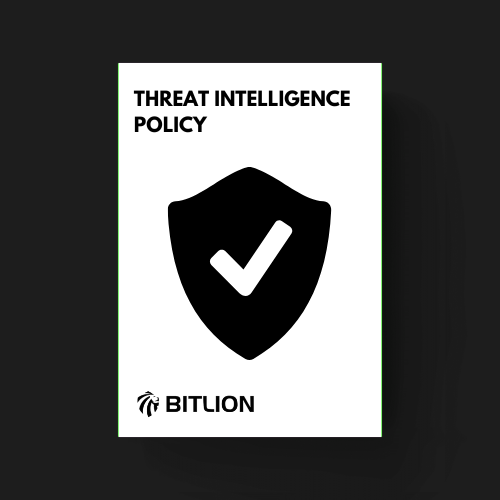
THREAT INTELLIGENCE POLICY
The purpose of this Threat Intelligence Policy is to establish a structured approach to identifying, assessing and mitigating security threats. This policy ensures that the organization proactively collects, analyzes and responds to security threats to protect information assets, operations and systems in accordance with the ISO 27001 standard.
1. Purpose
The purpose of this Threat Intelligence Policy is to establish a structured approach to identifying, assessing and mitigating security threats. This policy ensures that the organization proactively collects, analyzes and responds to security threats to protect information assets, operations and systems in accordance with the ISO 27001 standard.
2. Scope
This policy applies to all employees, contractors, and third parties who handle or have access to the organization's information assets. This policy covers the identification, assessment, communication, and integration of threat intelligence into the Information Security Management System (ISMS).
3. Annex References
This policy is aligned with the following ISO 27001 Annex A controls:
- A.5.7 Threat intelligence
- A.6.1 Internal organization
- A.8.1 Asset management
- A.12.4 Logging and monitoring
- A.16.1 Information security incident management
4. Principles
- Proactive Identification : Continuously monitor potential threats.
- Risk Based Approach : Assessing threats based on impact and likelihood of occurrence.
- Timely Communication : Sharing intelligence with relevant stakeholders.
- Continuous Improvement : Improving ISMS based on intelligence insights.
5. Objectives
- Identify existing and emerging threats : Detect potential threats to organizational assets.
- Assess risk and impact : Evaluate threats based on likelihood and business impact.
- Effective communication : Ensuring stakeholders receive threat intelligence in a timely manner.
- Improving ISMS : Update policies, procedures, and controls based on threat intelligence.
6. Source of Information
Threat intelligence is obtained from internal and external sources:
| Source Type | Threat Intelligence Sources |
| Internal Sources | - Antivirus logs - Incident report - Phishing report - Internal audit findings - Security monitoring tools (SIEM) |
| External Sources | - CISA Warning - CSV Report - Information security community - NIST vulnerability database - Government and industry warnings |
7. Roles and Responsibilities
| Role | Responsibility |
| Chief Technology Officer (CTO) | Oversee threat intelligence programs, ensure compliance with ISO 27001, and make strategic security decisions. |
| Chief Risk Officer (CRO) | Continuously monitor threat intelligence sources, analyze data, and escalate when necessary. |
| Incident Response Team | Investigate and respond to threats identified through intelligence sources. |
| IT Security Team | Implement security controls based on threat intelligence findings. |
| Risk Management Team | Assess risks based on intelligence gathered and update risk register. |
| Compliance Team | Ensure threat intelligence activities comply with regulations and ISO 27001. |
| Employee | Report phishing, suspicious activity, and security incidents. |
8. Threat Intelligence Life Cycle
Organizations follow a structured threat intelligence lifecycle to ensure effective threat identification and mitigation:
- Collection : Gathering intelligence from internal and external sources.
- Processing : Filtering, categorizing, and storing the collected intelligence.
- Analysis : Identify patterns, trends, and potential risks.
- Dissemination : Sharing intelligence with relevant teams.
- Action & Review : Implement controls and continuously improve intelligence processes.
9. Sharing Information and Communication
- Threat intelligence reports will be shared with senior management, security teams, and relevant stakeholders.
- Critical threats must be immediately executed to the Incident Response Team.
- Periodic intelligence briefings will be conducted to raise awareness.
10. Continuous Improvement
- The threat intelligence process will be reviewed at least annually.
- Post-incident reviews will integrate lessons learned into the ISMS.
- The security awareness program will be updated based on intelligence insights.
11. Compliance and Enforcement
Failure to comply with this policy may result in disciplinary action. Compliance audits will be conducted to ensure alignment with ISO 27001 requirements.
12. Review and Approval
This policy will be reviewed annually or as needed to accommodate new threats and regulatory changes.

